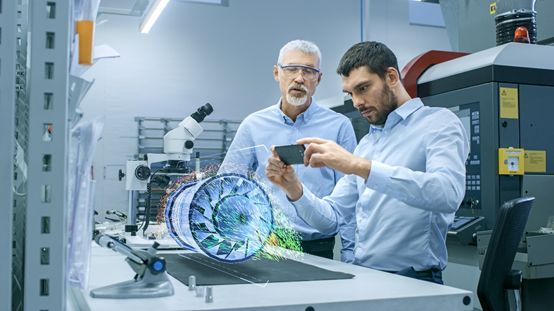 在智能手机创造的AR环境中,用户可以看到汽车发动机涡轮3D模型。(图片来源:Gorodenkoff / Shutterstock.com)
在智能手机创造的AR环境中,用户可以看到汽车发动机涡轮3D模型。(图片来源:Gorodenkoff / Shutterstock.com) 在VR/MR技术中呈现的一个发动机部件的横截面,可用于生产和调试。(图片来源:Monstar工作室 / Shutterstock.com)
在VR/MR技术中呈现的一个发动机部件的横截面,可用于生产和调试。(图片来源:Monstar工作室 / Shutterstock.com) 有了AR技术,工程师就能够在实体部件或工厂正式建成前进行修改,若在建成后才修改错误,变更成本将非常高昂。(图片来源:Theorem Solutions公司)
有了AR技术,工程师就能够在实体部件或工厂正式建成前进行修改,若在建成后才修改错误,变更成本将非常高昂。(图片来源:Theorem Solutions公司)
增强现实技术(AR)、混合现实技术(MR)与虚拟现实技术(VR)无处不在。在过去12个月至18个月中,与AR、MR以及VR相关的新设备与新应用大量涌现。而包括苹果、谷歌、微软、索尼、三星、HTC、Facebook、惠普等公司在内的所有科技巨头,也都将目光转向了AR、MR与VR市场。
虽然这些新兴技术是由游戏与社交媒体巨头所开发的,但它们最终都会不可避免地进入工程业与制造业中,其中包括商用车、卡车以及非公路车辆等行业。
那么,将这些让你能够在虚拟环境中进行赛车、射击外星人,或是捕捉口袋精灵的技术应用于卡车、工程机械以及非公路用车或防务车辆的设计与建造中,会带来怎样的影响?
VR技术应用于工程与制造领域已经有了相当一段时间了。CAVE系统以及Powerwall系统也已经投入使用达数十年之久。不过,在VR技术尚未普及之前,行业中只有少部分“拥有特权”的企业(主要是汽车与航空航天OEM)才能使用这些造价惊人的数据可视化系统。
AR、MR或VR技术在商用车、卡车与非公路用车工程制造中的应用仍处于早期阶段。大部分相关企业仍在探索采用AR、MR或VR设备的原因与必要性,以及这些设备在工程制造中的具体应用。不过,一旦它们深入了解了这些技术,就会看到它们在复杂产品与大规模生产中的显著优势。
游戏图形引擎在工程数据处理中的应用
一款游戏能否成功,很大程度上取决于游戏的3D画质如何。如果画质不高,那么玩家就体验不到游戏的真实性,游戏外观与质量都会大打折扣。游戏开发者利用图形引擎与一些包括动作捕捉技术在内的附加技术,可以设计出鲜明的画面,从而提升游戏的互动式与沉浸式体验。从游戏图形较高的质量与性能来看,游戏图形引擎完全能够胜任CAD数据的处理工作。
图形引擎性能的提高以及AR/MR与VR头盔成本的下降,使得CAVE或Powerwall等系统的价格从原先的数十万美元,甚至数百万美元,下降到了数万美元。
三十多年来,许多汽车公司都选择了采用3D CAD绘图软件进行汽车设计。如今,利用低成本、高性能的AR、MR与VR设备来显示CAD数据也已经成为了可能。
沉浸式体验在设计与生产中的应用
汽车工程师们如今都选择采用沉浸式AR、MR与VR体验平台以及AR、MR与VR设备来进行汽车设计与制造。
在汽车工程领域,VR技术可应用于汽车设计的虚拟审查、原型制作、搭建与组装,以及维修与培训中。有了VR技术的帮助,工程师们可以在虚拟现实环境中与他们的可视化设计数据进行互动,而不必花费额外的人力物力去制造大量的汽车实物模型。而当该模型所对应的是一辆40吨重的卡车时,采用VR技术的好处就更加显而易见了。此外,在模拟办公室、工厂或是露天环境的数字化场景(即虚拟现实的工作环境)中,工程师们还可以看到所有的原始设计数据。
相较于拥有30年发展历史的VR技术,AR技术与MR技术这两大“新兴”技术能够给使用者带来全新的视觉体验。因此我们日常使用的便携式设备,如笔记本电脑、智能手机或免提耳机以及头戴式显示器,都配备了AR与MR功能。
由于AR技术是一种在现实中叠加3D内容的技术,因而AR场景中的3D数据相当于现实物体所对应的数字孪生体。这些3D数据不但能够帮助维修人员更好地修理构造复杂的工厂与机械装置,而且还能够减少人员培训的开支。总之,AR技术通过将3D内容展现在真实的工厂环境中,来帮助工程师们评估整个汽车制造工艺流程、工厂培训以及服务工作的开展情况。
MR技术与AR技术类似,也是一种在现实中叠加数字内容的技术。不过,与AR技术不同的是,通过MR头罩所生成的MR内容,会以实时全息图的形式出现在现实世界中。因此,工程师可以在全息图中四处走动,也可以坐在里面,就仿佛置身于一个实体中一样。而这一切并非发生在数字化世界,它们就发生在现实的办公室、工厂或是测试工厂中。
在现实世界的环境中,工程师能够以自然直观的方式解读MR内容,因而也能更好地理解产品数据,并迅速确定产品规格尺寸与装配关系。有了该技术,工程师就能够在实体部件或工厂正式建成前进行修改,若在建成后才修改错误,变更成本将非常高昂。
数字化数据在真实环境中的显示
工程师们只需将CAD设计数据导入游戏图形引擎中,就可以通过装有AR、MR或VR功能的智能手机、平板电脑或耳机直接浏览这些设计数据,并在产品运作的现实世界中体验产品。
采用了AR、MR或VR技术后,工程师们能够在一个近乎“真实”的环境中,与自己的设计数据进行互动,并对产品设计早期阶段的数据进行修改,这既节省了时间,也节约了成本。
低价智能手机、平板电脑与耳机的日渐普及,意味着用户不用购买CAVE及Powerwall VR显示系统也能享受到AR、MR与VR体验。
虽然AR、MR与VR硬件与软件仍处在发展的早期阶段,但敢于接受这些新理念的工程与制造公司更有望保持行业领先地位。新技术能够为许多的传统工艺提供新思路,帮助工厂更好地完成生产任务。
Augmented, mixed and virtual reality (AR, MR and VR) are everywhere. Over the past 12-18 months the number of new devices and apps being released has risen significantly and all of the big tech players like Apple, Google, Microsoft, Sony, Samsung, HTC, Facebook and HP (among others) are getting in on the action.
Although these new technologies have been developed by the gaming and social media giants, it was inevitable that the technology would eventually work its way into the engineering and manufacturing world, including the commercial vehicle, truck and off-highway industries.
So how does using technology that usually lets you race cars, shoot aliens and capture Pokémon characters translate into designing and building trucks, construction machinery and off-highway or defense vehicles?
The use of VR in the engineering and manufacturing space is nothing new, with CAVEs and Powerwalls having been used for decades. However, it has always had an enormous price tag and only a few are in the “privileged” position (mainly large automotive and aerospace OEMs) to be fully able to utilize the technology for visualization—until now.
Using AR, MR or VR technology in commercial, truck and off-highway engineering and manufacturing is still very much in its infancy. Most organizations are just starting to figure out if, and why, they need these new devices and how they can potentially harness the technology. Once the technology is understood, the benefits of using it in an industry where the products are complex and the production is large scale, are obvious.
Gaming graphics for engineering data
Gaming relies on the quality of its 3D graphics—without good graphics, games look and feel unrealistic, and lack quality. The use of graphics engines, along with additional technology such as motion capture, allows gaming developers to create incredibly sharp graphics that feed such interactive and immersive experiences. Gaming graphics’ quality and performance are more than capable of handling the complex needs of CAD data.
These high-performance graphics engines, combined with low-cost AR/MR and VR headsets, have resulted in a price point of tens of thousands, rather than the hundreds of thousands, or millions of dollars for the CAVE or Powerwall.
With 3D CAD having been in use for 30 years by many companies in the automotive industry, the CAD assets that have been created can now be used by these new low-cost and high-performance devices.
Immersive experiences for design and production
Immersive experience platforms such as augmented, mixed and virtual reality, and the devices that deliver them, are being adopted by engineers to help with design and production.
For engineering, VR on the new devices can support: virtual design reviews, prototyping, building, assembly, service and training use-cases. It enables engineers to visualize and interact with their data in a far more realistic environment, without having to spend time and money on producing numerous physical models—and when the model is a 40-tonne truck, the benefit of not having to repeatedly create physical models is clear to see. The original data can be seen in the context of a digital scene representing the office, factory or open-air environment—a virtual reality work environment.
In comparison to VR’s established 30-year history, the “newer” AR and MR technologies offer totally new visual experiences, on portable “everyday” devices such as tablets and smartphones, or hands-free headsets and head-mounted displays.
Using AR—where the digital 3D content is overlaid onto the real world—means your 3D data can be used for Digital Twin applications, to aid maintenance personnel to repair complex plant and machinery, and train personnel at much lower cost. AR allows engineers to assess processes by overlaying 3D content in the factory environment and evaluate training and serviceability practices in situ.
MR is similar to AR in that it is an overlay of digital content onto the real world, but the MR content appears in the form of a hologram which sits in the real world, in real time, through a headset. Being a hologram, an engineer can walk around it and sit inside it just like a physical product, and this is done not in a digital world but rather in an office, factory or test facility.
Being in the real world means it is far more intuitive and natural, which improves understanding and enables decisions about form and fit to be quickly made. Changes can be made before any physical parts or plant is built, when mistakes are expensive to rectify.
Digital data, real environment
Passing CAD design data through a gaming graphics engine and then viewing it in an AR, MR or VR experience on a smartphone, tablet or headset, enables engineers to experience their products in the environments they design for and work in.
Using AR, MR or VR provides engineers with optimized capabilities on how best to use and interact with their design data in a close to “real” environment, while products are still in the early design stage, saving time and costs.
The growing accessibility of low-cost smartphones, tablets and headsets means that augmented, mixed and virtual reality technologies are no longer only available to those with VR CAVEs and Powerwalls.
Whilst it is still early days with the new hardware and software, undertaking proof of concepts now will enable engineering and manufacturing organizations to be ahead of the game. Many existing processes can harness the new technology, enabling new ways of performing established tasks.
Stuart Thurlby, CEO of Theorem Solutions, wrote this article for Truck & Off-Highway Engineering as part of our annual Executive Viewpoints series.
Author: Stuart Thurlby
Source: SAE Automotive Engineering Magazine
等级
打分
- 2分
- 4分
- 6分
- 8分
- 10分
平均分
- 作者:Stuart Thurlby
- 行业:汽车
- 主题:制造
